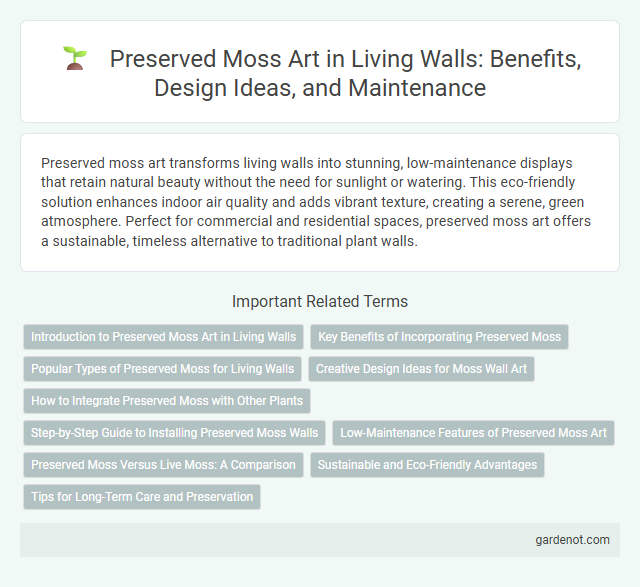Preserved moss art transforms living walls into stunning, low-maintenance displays that retain natural beauty without the need for sunlight or watering. This eco-friendly solution enhances indoor air quality and adds vibrant texture, creating a serene, green atmosphere. Perfect for commercial and residential spaces, preserved moss art offers a sustainable, timeless alternative to traditional plant walls.
Introduction to Preserved Moss Art in Living Walls
Preserved moss art in living walls provides a sustainable and maintenance-free alternative to traditional greenery, utilizing naturally preserved moss to create vibrant, textured vertical displays. This art form retains the organic look and feel of fresh moss while requiring no sunlight or watering, making it ideal for indoor environments. Incorporating preserved moss in living walls enhances indoor air quality and adds a calming, biophilic element to modern interior design.
Key Benefits of Incorporating Preserved Moss
Preserved moss offers exceptional air-purifying qualities by naturally filtering airborne toxins and enhancing indoor air quality without requiring sunlight or watering. Its low maintenance and long-lasting nature make it an ideal choice for sustainable interior decor, providing a lush, green aesthetic year-round. Incorporating preserved moss also contributes to sound absorption, reducing noise pollution and creating a calming environment in both residential and commercial spaces.
Popular Types of Preserved Moss for Living Walls
Popular types of preserved moss for living walls include reindeer moss, sheet moss, and cushion moss, each offering unique textures and vibrant green hues. Reindeer moss is renowned for its soft, branching structure and excellent color retention, making it ideal for creating intricate patterns. Sheet moss provides a lush, carpet-like coverage, while cushion moss adds depth and dimension, enhancing the overall aesthetic of living wall installations.
Creative Design Ideas for Moss Wall Art
Preserved moss art transforms living walls into vibrant, low-maintenance installations by utilizing sustainably sourced moss preserved at peak freshness. Creative design ideas for moss wall art include incorporating geometric patterns, botanical shapes, or mixed-media elements like driftwood and stones to add texture and depth. These designs enhance indoor air quality and bring natural tranquility to commercial and residential spaces through customizable color palettes and organic forms.
How to Integrate Preserved Moss with Other Plants
Integrating preserved moss with living plants enhances texture and visual interest in living wall designs by combining the moss's soft, vibrant green with the varied foliage of other species. Select plants with similar humidity and light requirements to ensure harmony and longevity, such as ferns, succulents, and air plants, which thrive alongside preserved moss. Use modular panels or frames to arrange moss and plants in distinct sections, promoting healthy growth and easy maintenance while creating striking biophilic art installations.
Step-by-Step Guide to Installing Preserved Moss Walls
Start by selecting a sturdy backing board treated for moisture resistance, measuring the desired wall area. Attach a frame or grid system to secure preserved moss panels, ensuring even spacing for natural expansion. Use a strong adhesive or staple gun to fix preserved moss firmly, pressing gently to avoid damage and maintain texture.
Low-Maintenance Features of Preserved Moss Art
Preserved moss art requires minimal upkeep, as the moss is treated to maintain its color and texture without needing water, sunlight, or soil. Its natural resilience makes it ideal for indoor environments where traditional plants struggle to thrive. This low-maintenance feature ensures long-lasting greenery that enhances interior aesthetics without the hassle of regular care.
Preserved Moss Versus Live Moss: A Comparison
Preserved moss offers long-lasting, maintenance-free greenery that retains its vibrant color and texture without the need for water or sunlight, unlike live moss which requires consistent care and specific environmental conditions. The preserved variety is treated with natural preservatives, ensuring durability and resistance to decay, making it ideal for indoor living walls where humidity and light levels can fluctuate. Live moss, while providing natural air-purifying benefits and a dynamic ecosystem, may suffer from browning and die-off if not properly maintained, limiting its use in controlled environments.
Sustainable and Eco-Friendly Advantages
Preserved moss art offers a sustainable and eco-friendly alternative to traditional living walls by requiring no watering, fertilizing, or natural light, thereby reducing water consumption and energy use. Its long-lasting preservation process minimizes waste and eliminates the need for frequent replacements, supporting ecological balance. This green decor solution enhances indoor air quality while maintaining a natural aesthetic without disturbing living ecosystems.
Tips for Long-Term Care and Preservation
Preserved moss art requires consistent humidity levels between 40-60% to maintain its vibrant texture and color over time. Avoid direct sunlight and excessive moisture, as exposure can cause fading and mold growth, compromising the moss's integrity. Regularly dust the surface with a soft brush or gentle vacuum to prevent buildup without damaging the delicate preserved moss structure.
Preserved moss art Infographic

 gardenot.com
gardenot.com